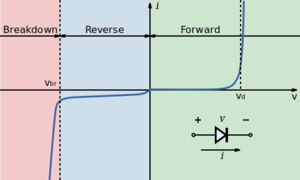Difference between revisions of "Silicon photomultiplier"
| Line 7: | Line 7: | ||
A SiPM detector is formed by a pixelated matrix of photodiodes. Each photodiode consists of a junction of positively and negatively doped silicon ('''p-n junction'''). A depleted region which is devoid of free charge carriers is formed in between the differently doped silicon materials. By applying a reverse-voltage to the photodiodes, the depleted region can be enlarged to extend through the entire sensor. | A SiPM detector is formed by a pixelated matrix of photodiodes. Each photodiode consists of a junction of positively and negatively doped silicon ('''p-n junction'''). A depleted region which is devoid of free charge carriers is formed in between the differently doped silicon materials. By applying a reverse-voltage to the photodiodes, the depleted region can be enlarged to extend through the entire sensor. | ||
| − | + | [[File:Iv characteristic diode.png|thumb|right|Current-Voltage characteristic of a diode. A SiPM operates in the Breakdown regime.]] | |
| − | |||
| − | |||
The passage of ionizing radiation through a photodiode creates electron-hole pairs. These liberated charge carriers are accelerated by the electric field in the depleted region towards the anode (holes) or cathode (electrons). If the reverse-voltage is high enough to exceed the breakdown voltage of the p-n junction, the diode is said to operate in '''Geiger-mode'''. The energy of a single charge carrier accelerated by the electric field is sufficient to create additional electron-hole pairs which in turn liberate even more charge carriers. Ultimately, the multiplication process can lead to a self-sustaining avalanche. | The passage of ionizing radiation through a photodiode creates electron-hole pairs. These liberated charge carriers are accelerated by the electric field in the depleted region towards the anode (holes) or cathode (electrons). If the reverse-voltage is high enough to exceed the breakdown voltage of the p-n junction, the diode is said to operate in '''Geiger-mode'''. The energy of a single charge carrier accelerated by the electric field is sufficient to create additional electron-hole pairs which in turn liberate even more charge carriers. Ultimately, the multiplication process can lead to a self-sustaining avalanche. | ||
Revision as of 17:48, 4 April 2020
Silicon photomultipliers (abbrev. SiPM) are photon-sensitive detectors operating as Single-photon avalanche diodes (SPAD).
Contents
Principle of Photodiodes
A SiPM detector is formed by a pixelated matrix of photodiodes. Each photodiode consists of a junction of positively and negatively doped silicon (p-n junction). A depleted region which is devoid of free charge carriers is formed in between the differently doped silicon materials. By applying a reverse-voltage to the photodiodes, the depleted region can be enlarged to extend through the entire sensor.
The passage of ionizing radiation through a photodiode creates electron-hole pairs. These liberated charge carriers are accelerated by the electric field in the depleted region towards the anode (holes) or cathode (electrons). If the reverse-voltage is high enough to exceed the breakdown voltage of the p-n junction, the diode is said to operate in Geiger-mode. The energy of a single charge carrier accelerated by the electric field is sufficient to create additional electron-hole pairs which in turn liberate even more charge carriers. Ultimately, the multiplication process can lead to a self-sustaining avalanche.
